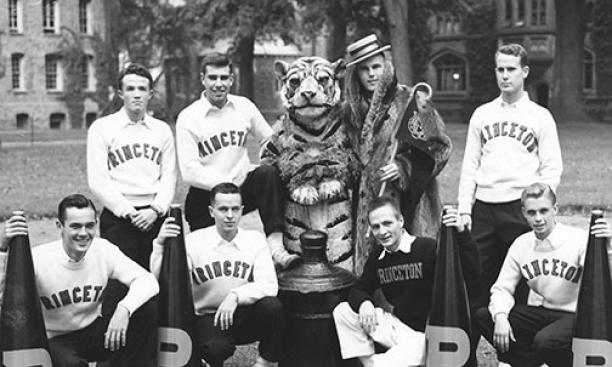
Near midnight on April 19, 1861, the Seventh New York Regiment came through Princeton by train (the tracks ran near Lake Carnegie), and undergraduates heard the soldiers’ dramatic “rocket” cheer, “ssss-boom-ahhh!”
Thus, it is said, we learned our college cheer, still used today. Nineteenth-century students gave the “Tiger-skyrocket” as a stately “Hurrah! Hurrah! Hurrah! Tiger! Ssss-boom-ahhh!” — the last syllables imitating a crowd’s gasping admiration of a starburst.
In fact the cheer was merely reintroduced to campus in 1861. The “rocket” — often preceded by the long-customary “three cheers and a tiger” — was used here already, perhaps inspired by fireworks displays when the Atlantic Cable — the first transatlantic telegraph cable — was celebrated in 1858. Nationwide, militia groups popularized the rocket cheer by 1860.
In the 1890s we devised the “locomotive,” which speeds up as it goes along and today is rendered, “Rah rah rah! Tiger, tiger, tiger! Sis, sis, sis, boom, boom, boom, ah!” This gave more prominence to tigers, our mascot since the mid-1880s.
Cheerleading is said to have begun in 1898 at the University of Minnesota; actually, Princeton invented it. Informal Tiger “cheer-leaders” shouted at the 1885 Yale football match, and “regular cheer-leaders” were appointed in 1897. Copying Old Nassau, every college had its lusty cheers by the mid-1890s.
One hundred twenty years ago this summer, track star Henry “Spider” McNulty 1895 was a counselor at the new Camp Pasquaney in New Hampshire, where he taught the boys Princeton songs and the locomotive cheer. Pasquaney survives today as the nation’s oldest camp and continues to use his cheer, now called a “railroad”: “Hip, hip! Ray, ray, ray! Tie, tie, tie! Sis sis sis! Boom boom boom bah!” Even after more than a century, you still can hear a faint echo of tigers and skyrockets.
READ MORE: All About the ‘Ah’ —Tom Meeker ’56 on teaching the locomotive cheer
